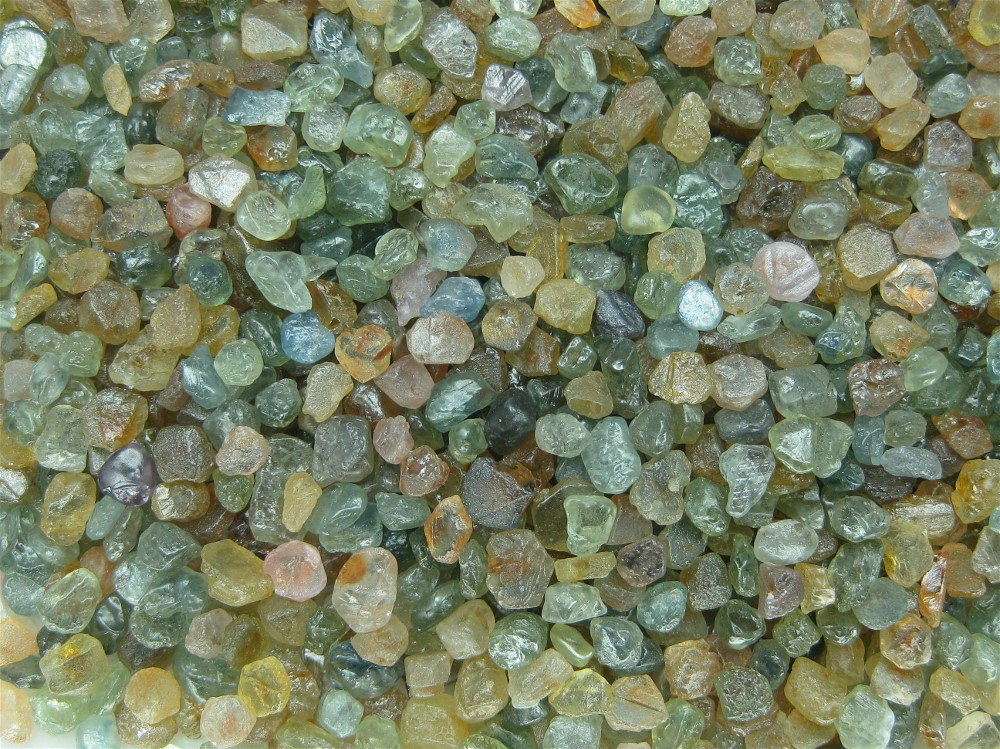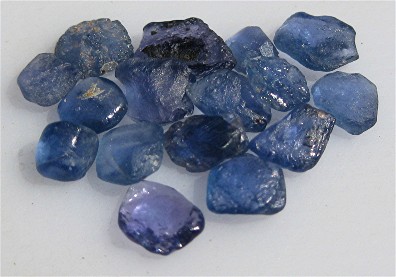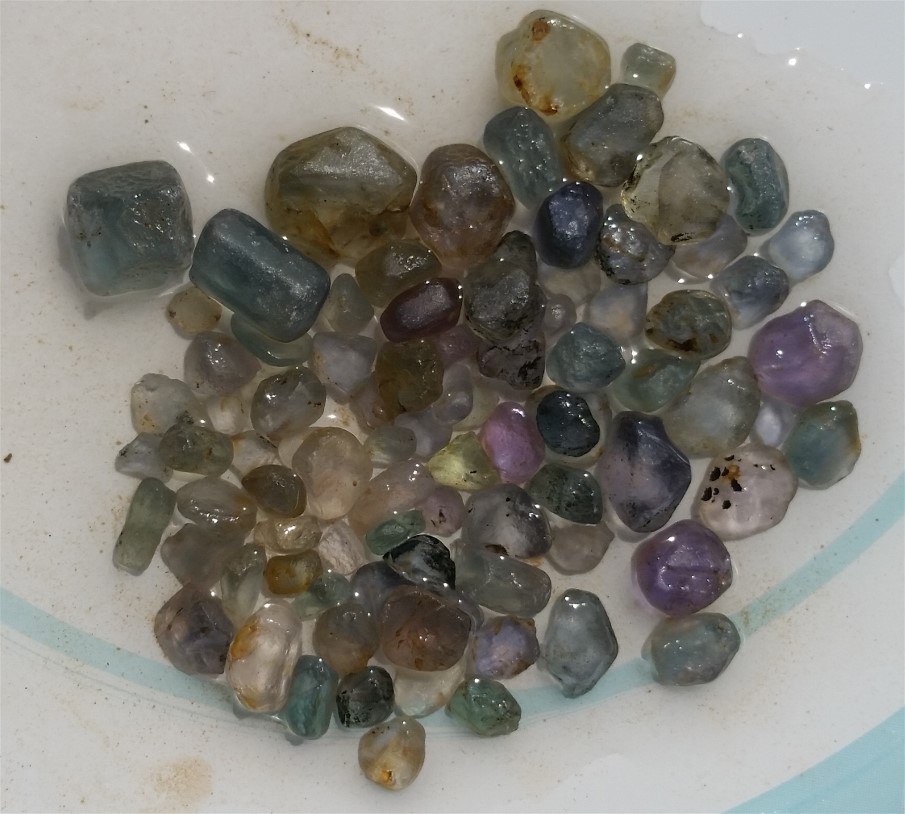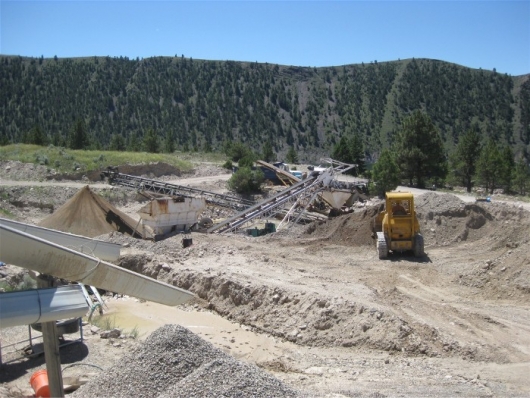Montana Sapphire
Most Americans do not realize that exquisite sapphires have long been mined from gravel bars and intrusive dikes in the state of Montana. There are a few reasons for this. First, the natural color of most of the Montana sapphire isn't the typical deep blue people associate with Sapphire from Sri Lanka, Myanmar, or Australia. Also, although there has always been the potential for large scale mining, the Montana sapphire reserves have rarely been exploited on a large scale mainly due to the costs and the regulations put on how you can mine in this country.

"Montana sapphire comes in many different shapes, sizes and colors. Sapphire from the El Dorado Bar along the Missouri River near Helena, tend to be some of the largest sapphires found in Montana. They can be found in large sizes, 2 to 10 carats, although most are in the 1 carat range. Colors are usually blue to bluish green, but colors such as yellow, orange, pink, violet, and red (ruby - rare), can also be found.
Sapphires from the Sapphire Mountain region, also known as Rock Creek Sapphire or Gem Mountain Region near Philipsburg are usually found in sizes smaller than a pea. Most are less than 1 carat in size but can be found as large 3 carats. What they lack in size they more than make up for in quantity and bright colors. Commonly found in blues and greens, colors such as yellow, orange, pink, violet, and red (ruby), can also be found." >From the U.S.G.A. (United States Geological Survey) database.
Heated Rock Creek Sapphire

The production of gem-quality sapphires in the United States is not new or recent. In 1865, the first U.S. sapphires were found in the gravels of the Missouri River in Lewis and Clark County, Montana. This was followed by subsequent discoveries on Dry Cottonwood Creek in Deer Lodge County in 1889, on Rock Creek in Granite County in 1892, and in Yogo Gulch in Judith Basin County in 1895. Additionally, small amounts of sapphire are recovered from Quartz Gulch in Granite County, Pole Creek in Madison County, the Missouri River in Chouteau County, and Brown's Gulch in Silver Bow County. Furthermore, corundum crystals, from which star sapphires have been cut, are found in Beaverhead and Madison Counties.
Heated Dry Cottonwood Creek Sapphire

Mining of Yogo Gulch sapphires began within a year of their discovery in 1895 and continued for 39 years. In 1923, the mine was damaged so badly by rain that it could not economically recover. Other attempts have been made to commercially mine the deposit, but to date, all of these attempts have ended in economic failure.
Yogo's are unique among the world's sapphires. They lack the color zoning so prevalent in other sapphires, their uniform "corn-flower blue" color is natural (not the result of heat-treating), and their clarity is uniformly high. These features rank them among the world's finest sapphires. Unfortunately, the rough is both small and flat, wafer-like in shape. The majority of the crystals or pieces of crystals recovered are too small to be cut, most are less than 1 carat and finds of over 2 carats are rare. Reportedly, the largest crystal was a 19 carat stone found in 1910 that was cut into an 8-carat stone. The size of the cut stones greatly restricts the market for Yogo's. They are beautiful, small, very expensive sapphires.
Currently, Yogo sapphires are produced from three sources: Rancor lnc. produces material from the original Yogo Gulch deposit; Vortex Mining produces from a recently discovered extension of the Yogo dike; and material is produced by individuals from privately owned lots in Sapphire Village. The first two producers market only cut stones and finished goods and the third is comprised essentially of hobbyists.
Historically, the amount of sapphires produced from the Missouri River and Rock Creek areas greatly exceeded that from Yogo Gulch. However, the value of the material produced from Yogo, reported to be in excess of $30 million, is significantly greater than that of the combined values of the other areas. This relationship is rapidly changing.
Yogo Sapphire

The combination of large volume commercial operations on the Missouri River, and to some extent Rock Creek, plus the advent of successful heat-treating techniques for the material has greatly enhanced the acceptance of these sapphires by the gemstone industry. This enhanced acceptance has resulted in a significant increase in the market for and value of U.S. sapphires. Unconfirmed reports have circulated that a parcel of select 3- to 10-carat material, suitable for heat-treating, was sold for as much as $40,000 per kilogram. A more realistic price for 3- to 10-carat, sorted mine-run material is in the range of $5,000 per kilogram, with many kilograms of mine-run rough selling for $1,000 per kilogram.
The sapphires from the Missouri River gravels in Lewis and Clark County are a mixture of rough and pitted crystals showing well defined faces and completely rounded and smooth-surface highly stream worn pebbles. The majority of the material is pale blue or blue-green, with deep blue stones quite rare. Stones also are found in pastel blue, green, pink, pale red, purple, yellow, and orange. Most of the stones recovered are less than 6.4 millimeters in diameter, but material 6.4 to 12.7 millimeters in diameter are not uncommon. Material greater than 12.7 millimeters in diameter is rare. One other aspect that make Missouri River sapphire so attractive and desirable, besides their natural brilliance, is their ability to color shift / change. Only non-heated Missouri River sapphire have this color change ability, and no other sapphires from any of the other deposits within Montana do.
Currently there are seven operations on the Missouri River that commercially mine sapphires and/or operate a dig-for-fee area. Not all of these may be active in any one year. The mines operate from about the last week of May through the first week of September.
Natural Missouri River Sapphire newly dug

Sapphire Mine, Eldorado Bar along the Missouri River

There are a number of locations between Dillon in Beaverhead County and Ennis in Madison County that produce lavender, grayish-lavender, bluish-gray, and gray hexagonal sapphire crystals that, when cut, produce stones that contain four- or six-ray stars. At least one producer from the Dillon area is currently advertising the availability of this type of material. The remainder of the sapphire deposits in Montana appears to be operated by individual hobbyists.
More should be said about the effects of heat-treating techniques on Montana sapphires, and the variety of fancy colored sapphires available. Not all Montana sapphires are suitable for heat- treating because of variations in chemical composition. Also, the sapphires from the Missouri River respond to heat-treating differently than those from Rock Creek The response to heat-treating can vary also depending upon the method (individual) used to treat the sapphires.
The yield on treatment of Missouri River sapphires is lower than for Rock Creek. It is reported that 20% to 30% of Missouri River sapphires heat-treat from deep, well saturated blue to pale, pale blue. The corresponding treatment rate for Rock Creek material is in the range of 60%. Heat-treating also yields or improves the color of fancy colored sapphires. Bright yellows and oranges are the result of heat-treating, whereas heat-treating improves the color of some pinks by removing colors that can interfere with the desirable pink shades. Montana sapphires can be diffusion treated, but because of their high iron content they are not particularly well suited for this form of enhancement.
To Purchase Sapphire Gravel "CLICK HERE"
To View or Purchase any of my Amazing Hand Mined Cut Montana Sapphire "CLICK HERE"
To Purchase Yogo Sapphire ore directly from the mine "CLICK HERE"







